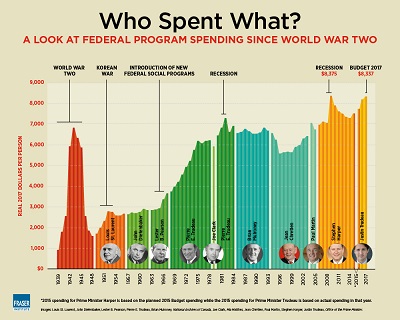
The Fraser Institute in Vancouver, Canada has published a short but illuminating study of federal government spending for the last 150 years. (Disclosure: I am a senior fellow with the Fraser Institute.) The study is titled “Prime Ministers and Government Spending: A Retrospective.” The authors, Jason Clemens and Milagros Palacios, highlight the most important findings in their summary.
Important note: their data are on program spending and do NOT include interest on the federal debt.
Here’s what I found striking.
1. The World War II ratchet, a la Robert Higgs in Crisis and Leviathan. (See their Figure 1.) As in the United States, real government spending per person fell off a cliff after World War II, but not close to it’s pre-WWII level. See my Mercatus study “The U.S. Postwar Miracle” for more on the U.S. case.
2. Arguably the most-libertarian Canadian prime minister, Sir Wilfrid Laurier, didn’t do so great on reining in government spending, to put it mildly. (Again, See Figure 1.)
3. The best two on program spending who were Prime Ministers for more than a few years were Brian Mulroney and Jean Chretien, both of whom decreased real per capita spending on programs by an annual average of 0.3 percent. I highlighted Chretien’s accomplishments in my Mercatus study “Canada’s Budget Triumph.” Why didn’t I highlight Mulroney’s accomplishments? Because I looked at overall federal spending, not just program spending.

READER COMMENTS
Dan
May 11 2017 at 3:48pm
Interesting. Why examine this on a per capita basis? Wouldn’t spending as % GDP make more sense?
David R Henderson
May 11 2017 at 5:38pm
@Dan,
In my studies, I looked at spending as a % of GDP because, like you, I think it makes sense. But it’s also interesting to see it in per capita terms.
Thomas Sewell
May 11 2017 at 8:44pm
Why would % of GDP make more sense? Is there some quality of government spending which relates closer to GDP than to the number of people?
Per capita in constant dollars seems to make the most sense to me. You can argue government expenditures should change as the population changes, but shouldn’t GDP (which already includes government spending in part) be at most loosely coupled to government spending, with more causation going the other way overall?
What other types of spending do we commonly track as a percentage of GDP over time? What’s the relationship with GDP supposed to accomplish, implying the more wealth we create, the more must automatically go to government programs?
mariorossi
May 12 2017 at 7:35am
I think that looking at the ratio to GDP is more sensible.
Assuming government is providing public goods, it would seem reasonable that the amount of public goods desired is a function of overall income.
Since the government provides health-care in Canada, it would seem reasonable that public spending increases with income.
You could also argue that demographic distribution should be taken in account as well. As the age distribution changes, you might justify different spending levels. A society with 80% participation rate probably should run different spending levels to a society with 60% participation rate.
Andrew_FL
May 13 2017 at 1:39pm
Spending in % of GDP terms would probably evaporate any supposed WWII “ratchet.” As it is, it looks like a much greater ratchet effect occurred for the Korean war.
It also seems silly to focus on the effects of wars when timing suggests the biggest permanent ratchet upwards by far was associated with social programs, not defense build up.
Thomas Sewell
May 13 2017 at 7:48pm
@mariorossi There is a relationship, but GDP doesn’t equal income. You’ve made an argument for looking at government spending in relationship to per capita income, but not in relation to GDP.
If much of government spending is demographically driven (social security, public schools), then it may make sense to adjust for demographic changes over time as well.
Perhaps a more sophisticated analysis would be to adjust for the demographic differences and adjust for the income affect (presumably some parts of government spending are closer to luxury goods than others, and thus should vary more with income), but I strongly suspect you’ll still find a big chunk of the increase in constant dollars over time isn’t actually accomplishing any of that.
Andrew_FL
May 14 2017 at 2:40am
The better argument is that our measures of inflation are very dubious but GDP adjusts for inflation implicitly rather than explicitly and therefore avoids the issues of dubious price indices for calculating “real” levels of government spending.
Thomas Sewell
May 26 2017 at 10:45pm
Andrew_FL,
Sorry for the late response, but using GDP to adjust figures for inflation would make more sense if you were using nominal GDP, not real GDP, which supposedly removes the impact of monetary inflation, and if you were using nominal spending, instead of inflation-adjusted spending. That’s a REALLY long way to go around to get some slight benefit of a better inflation adjustment.
Is there any other area where the spending on something is routinely measured year-over-year by comparing it against GDP instead of using normal inflation adjustments? If not, then why is government spending a special case?
Comments are closed.